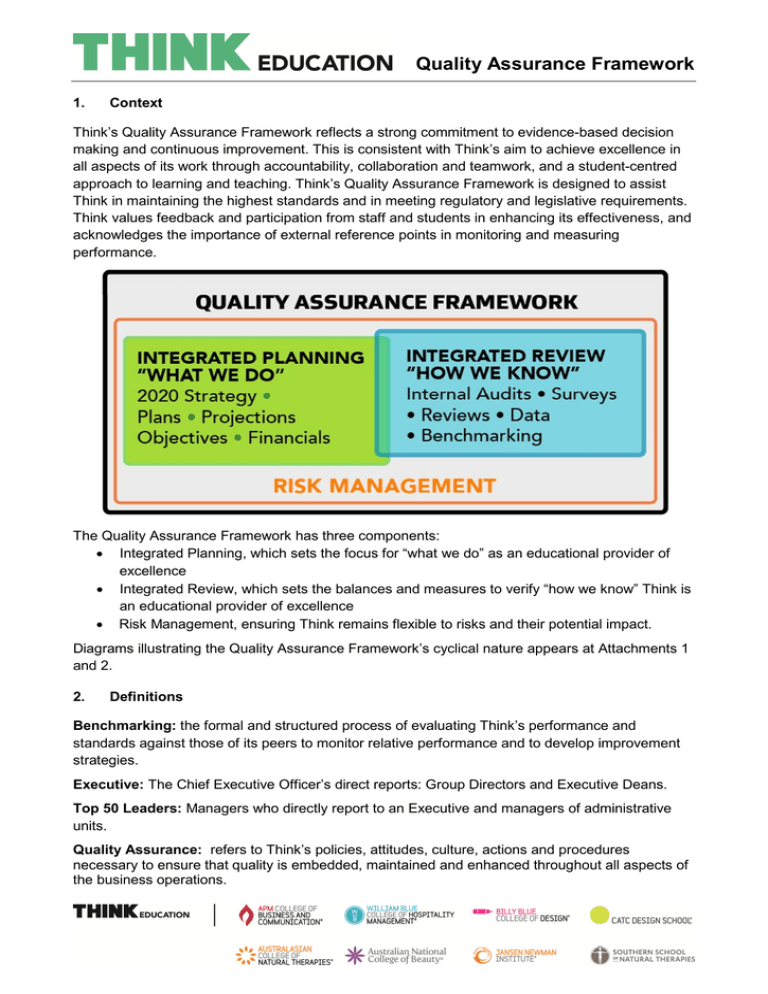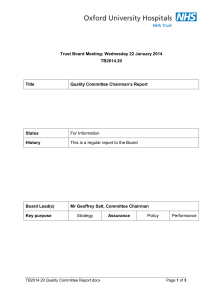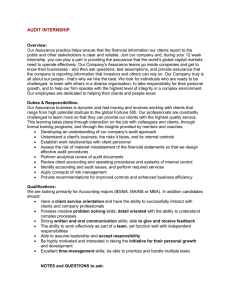Quality Assurance Framework
advertisement

Quality Assurance Framework 1. Context Think’s Quality Assurance Framework reflects a strong commitment to evidence-based decision making and continuous improvement. This is consistent with Think’s aim to achieve excellence in all aspects of its work through accountability, collaboration and teamwork, and a student-centred approach to learning and teaching. Think’s Quality Assurance Framework is designed to assist Think in maintaining the highest standards and in meeting regulatory and legislative requirements. Think values feedback and participation from staff and students in enhancing its effectiveness, and acknowledges the importance of external reference points in monitoring and measuring performance. The Quality Assurance Framework has three components: • Integrated Planning, which sets the focus for “what we do” as an educational provider of excellence • Integrated Review, which sets the balances and measures to verify “how we know” Think is an educational provider of excellence • Risk Management, ensuring Think remains flexible to risks and their potential impact. Diagrams illustrating the Quality Assurance Framework’s cyclical nature appears at Attachments 1 and 2. 2. Definitions Benchmarking: the formal and structured process of evaluating Think’s performance and standards against those of its peers to monitor relative performance and to develop improvement strategies. Executive: The Chief Executive Officer’s direct reports: Group Directors and Executive Deans. Top 50 Leaders: Managers who directly report to an Executive and managers of administrative units. Quality Assurance: refers to Think’s policies, attitudes, culture, actions and procedures necessary to ensure that quality is embedded, maintained and enhanced throughout all aspects of the business operations. Quality Assurance Framework 3. Scope This framework applies to all staff of Think. 4. Principles To enable it to achieve its strategic promises, ensure quality outcomes and meet its statutory and regulatory obligations, Think is committed to: • a continuous improvement approach embedded at all levels of the business • evidence-based and inclusive decision-making processes • monitoring outcomes against its stated goals, performance indicators and targets • using internal and external review mechanisms to identify improvement opportunities and implement action plans/mitigation strategies • maintaining the Think: Values of honesty, ownership, teamwork and passion • developing a culture of ownership, participation and responsiveness where all staff understand their individual and collective responsibility for quality processes and outcomes • embedding the Plan, Implement, Monitor/ Review, and Improve (PIMI) quality assurance and continuous improvement model in all aspects of Think’s work. Quality Assurance Framework v2.docx Page 2 of 8 Quality Assurance Framework 5. Integrated Planning structure Think’s Integrated Planning structure sets the future focus for “what we do” (following the Plan, Implement and Improve stages from the PIMI model) including: • • • • • The 2020 Strategy which sets key academic and business promises and targets for 2015 and 2020 Financial Long-Range Plan that includes the capital management plan, projected income, expenditure and cash flows, balance sheet projections, aligned with projected staff and student numbers Workforce Plan which address engagement, retention, succession planning and professional development, aligned to projected staff and student numbers Product Strategy and Faculty Growth Strategies to complement the 2020 Strategy Supporting plans including annual: o High Return Activities / Goals o Budgets o Operational Plans (for Faculties, these include Teaching and Learning Plans) o A system of Key Performance Objectives (KPOs) and Indicators cascading from the 2020 Strategy and Think’s Gateway KPOs. 5.1. Planning and Review Cycle The annual Planning and Review Cycle allows Think to monitor performance against targets, identify desirable improvements, and ensure that operational planning and budgetary allocation supports the implementation of the 2020 Strategy. The cycle includes staff involvement at all levels. The cycle and all resulting plans are communicated and disseminated via Think’s staff portal. • Financial Management processes at Think have been implemented that reflect industry best practice. These include rolling 12 month budgetary reviews and forecasts, as well as ongoing and scheduled Long-Range-Planning. The Financial Management Cycle: Quality Assurance Framework v2.docx Page 3 of 8 Quality Assurance Framework 6. • The 2015 and 2020 targets relating to Think’s four promises are tracked over time. A dashboard indicating updated performance against targets is produced regularly for consideration by the Think Board. Indicators of learning quality (Academic Quality Reports from the Academic Board, survey results, course review reports, internal audit reports), student demand and satisfaction (survey results, course review reports, retention and internationalisation), financial viability (liquidity, operating efficiency, profitability), and human resource information (staff performance reviews against KPOs, staff promotion, qualifications and professional development) will also be considered. • A Strategic Review of Performance against Think’s 2020 Strategy and targets is undertaken annually by the Chief Executive Officer in consultation with the Executive and Top 50 Leaders. Consideration is given to internal factors (including learning quality, students, finances and human resources) plus external research relating to competitors and trends in education. A report is presented to the Think Board, which includes proposed improvement actions with specified timelines, aligned with identified performance gaps relative to targets. The Strategic Review provides the framework for forward planning and informs revisions/adjustments to the Financial Long-Range Plan, Workforce Plan, Product Strategy, Faculty Growth Strategies and all supporting plans. Integrated Review structure Think’s Integrated Review structure provides the parameters to determine “how we know” that Think is being effective and high standards are maintained, following the Review stage from the PIMI model. Regular checks are conducted to ensure Think fulfils regulatory and legislative obligations, and the principles established within this Quality Assurance Framework. 6.1. Internal audit Internal audits are conducted throughout the business to ensure Think meets its statutory and regulatory obligations, including workplace health and safety. The Internal Audit charter, strategy and annual work plan are overseen by the Audit and Risk Committee, which then reports on the adequacy of internal controls/standards to the Think Board. 6.2. Academic quality The Academic Board, under delegation of the Think Board, is responsible for quality assurance of all academic activities across Think faculties, including the maintenance of high standards in teaching and scholarship. All academic courses are subject to an annual Course Review in accordance with Think’s Course Review Policy and Procedure and the Faculty Teaching and Learning Plans. Course reviews focus on course structure, relevance of course content and how successful the course has been in achieving quality student outcomes, appropriate academic standards, and that regulatory requirements are addressed. Additional reviews may be prompted by negative trend indicators identified from the dashboard reports. Course Review Reports, including trend performance data (enrolments, retention, grades, student satisfaction) and comparative information relating to the currency of course content are submitted to the Academic Board for Quality Assurance Framework v2.docx Page 4 of 8 Quality Assurance Framework endorsement. Once endorsed, Course Review Reports are provided to the Think Board as assurance measure of course quality. In addition to the Course Review process, the Academic Board monitors academic quality by considering SESL results, student and staff satisfaction surveys, student retention and progression, student completions and graduate outcomes, profiles of academic staff, course audit findings, and benchmarking data from partner institutions. The Academic Board provides advice to the Think Board on academic quality matters. 6.3. Data and surveys Think has established processes to record and analyse student data, including retention, progression and completion, student satisfaction and student outcomes. Analysis of data informs improvement activities actioned throughout Think and subsequently evaluated for effectiveness. Think has a systematic approach to obtaining feedback from students, employers of students, industry, staff and external stakeholders. As well as having in-house surveying capability, Think participates in external surveys to gather data for benchmarking performance against other institutions. Survey and benchmarking results are methodically analysed so that Think can identify areas in need of improvement, develop action plans to improve target areas and evaluate effectiveness of actions taken. 6.4. Policy development and review Think maintains two types of policies to ensure high standards are maintained: academic and operational. Operational policies address internal approaches to Think operations such as human resources, marketing, finance and information technology. Academic policies are student-facing and are developed with input from content experts and key stakeholder groups. Each academic policy is reviewed at least every three years, while feedback from users, changes in legislative or regulatory requirements, or changes in strategy may prompt an earlier review. 6.5. Benchmarking Think engages in four different types of benchmarking activities. It uses publicly available data to undertake (a) sector benchmarking to compare performance outcomes with other education providers. Think also participates in (b) whole-of-business benchmarking with selected partners where a range of processes, activities and practices are compared to identify strengths and weaknesses as a basis for improvement. (c) Discipline-specific benchmarking is used for academic course reviews while (d) Standards-based benchmarking is also used to analyse outcomes against an external set of standards. 6.6. Staff The Performance Management Policy provides a formal framework for staff performance reviews against Key Performance Objectives. Staff participate annually in a performance review with their supervisors to set objectives, exchange feedback about performance and Quality Assurance Framework v2.docx Page 5 of 8 Quality Assurance Framework achievement, identify training and development needs, and, in the case of outstanding performance, provide a basis for determining a performance bonus payment. 6.7. Faculty and administrative unit reviews Evaluations of all faculties and administrative units are undertaken periodically, at least once every five years. Reviews evaluate past performance based on agreed indicators, and consider future prospects in the context of Think’s strategic promises. 7. Risk Management Think’s Risk Management processes support due diligence in decision making, an awareness and understanding of business risks and their impact, and the exercise of appropriate duty of care, following the Improve and Plan stages from the PIMI model. The Register of Material Business Risks is maintained centrally, with risk assessment and identification activities embedded throughout Think’s operations in order to identify continuing and emerging risks, including workplace health and safety. Risks and their mitigation strategies are established and monitored by Think’s CEO and the Executive. Reports on Think’s risks are periodically provided to Think’s Audit and Risk Committee for endorsement prior to submission to the Think Board. Quality Assurance Framework v2.docx Page 6 of 8 Attachment 1 Quality Assurance Framework v2.docx Page 7 of 8 Attachment 2 – annual cycle Quality Assurance Framework v2.docx Page 8 of 8



